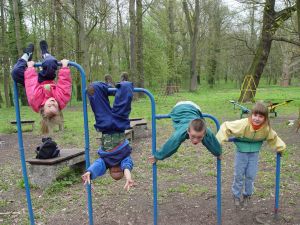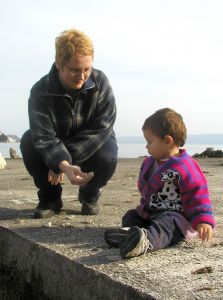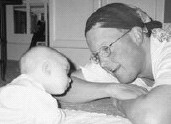From API’s Publications Team
 A January 6 article in the United Kingdom’s Nursery World magazine, “A Unique Child: Attachment – Practice in Pictures – A Sense of Security,” illustrates the difference between a securely and insecurely attached child.
A January 6 article in the United Kingdom’s Nursery World magazine, “A Unique Child: Attachment – Practice in Pictures – A Sense of Security,” illustrates the difference between a securely and insecurely attached child.
Secure attachment, according to the article’s author Anne O’Connor, creates empathy between the parent and child, so that the child “begins to appreciate that their caregivers can have feelings and needs of their own.” In addition, as conflicts arise, secure attachment allows the child and parent to develop a partnership in resolving the situation.
According to O’Connor, secure attachment occurs when a child has a safe, affectionate, and predictable emotional bond with his attachment figures, whether primary or secondary, with these main features:
- Sensitivity;
- Affection; and
- Responsiveness.
“Secure attachments provide a safe base for a child, reducing fearfulness and stress while building confidence and self-esteem,” O’Connor writes. In essense, the child learns through countless positive experiences that her attachment figure can be relied upon to meet her needs.
Also, secure attachment helps the child to develop self regulation toward stress, which helps in conflict resolution such as preventing potential tantrums.
Children with insecure attachments, on the other hand, tend to over-react to minor stressors, unable to self-regulate their stress levels. In addition, these children – because they cannot trust their attachment figures to provide consistent, reliable emotional care – have difficulty in empathizing with their caregivers. By not connecting in this way, the child has less chance of getting emotionally hurt.
To read the entire article, go to www.nurseryworld.co.uk/news/871318/Unique-Child-Attachment—Practice-pictures—sense-security/.
 People talk about the “problem child,” but I’m not really sure what a problem child is.
People talk about the “problem child,” but I’m not really sure what a problem child is. Depression — a mental illness marked by unrelenting sadness and hopelessness that permeates the lives of an estimated one in 18 people — is among the most prevalent medical disorders in today’s world, affecting 12 percent of women, 7 percent of men, and 4 percent of adolescents in a given year. Eight percent of adults will develop depression sometime in their life, and women are most prone — their lifetime risk is 20 percent.
Depression — a mental illness marked by unrelenting sadness and hopelessness that permeates the lives of an estimated one in 18 people — is among the most prevalent medical disorders in today’s world, affecting 12 percent of women, 7 percent of men, and 4 percent of adolescents in a given year. Eight percent of adults will develop depression sometime in their life, and women are most prone — their lifetime risk is 20 percent. Dahlia was running around the house screaming and crying. “I hate her! I hate her! I will never play with her again!”
Dahlia was running around the house screaming and crying. “I hate her! I hate her! I will never play with her again!” A January 6 article in the United Kingdom’s Nursery World magazine, “A Unique Child: Attachment – Practice in Pictures – A Sense of Security,” illustrates the difference between a securely and insecurely attached child.
A January 6 article in the United Kingdom’s Nursery World magazine, “A Unique Child: Attachment – Practice in Pictures – A Sense of Security,” illustrates the difference between a securely and insecurely attached child. The Public News Service published an article featuring API Co-founder Lysa Parker’s perspective on U.S. President Barack and First Lady Michelle Obama’s family values.
The Public News Service published an article featuring API Co-founder Lysa Parker’s perspective on U.S. President Barack and First Lady Michelle Obama’s family values. According to an article on InTheNews.co.uk, “One in Four Aussie Kids Have Parent with Mental Illness,” mentally ill parents are more likely to form insecure attachments with their children.
According to an article on InTheNews.co.uk, “One in Four Aussie Kids Have Parent with Mental Illness,” mentally ill parents are more likely to form insecure attachments with their children. Our children model our behavior. When surrounded by people who love them and respond to them sensitively and empathetically, they learn to respond this way to others. In my view, the API principle of Responding with Sensitivity best illustrates the concept of Attachment Parenting (AP). I may or may not adhere to all the principles of AP, but if emotional responsiveness does not permeate my parenting, then I question whether I can cultivate a strong bond with my children.
Our children model our behavior. When surrounded by people who love them and respond to them sensitively and empathetically, they learn to respond this way to others. In my view, the API principle of Responding with Sensitivity best illustrates the concept of Attachment Parenting (AP). I may or may not adhere to all the principles of AP, but if emotional responsiveness does not permeate my parenting, then I question whether I can cultivate a strong bond with my children.
 It’s one thing to understand how remaining calm, supportive and objective can be a great service to our children and another thing to do it when we’re exhausted, frazzled, and sleep-deprived.
It’s one thing to understand how remaining calm, supportive and objective can be a great service to our children and another thing to do it when we’re exhausted, frazzled, and sleep-deprived. When a parent utters the word tantrum to another parent, the reaction is either a supportive smile or a grimace of dread; I have yet to see or hear another parent respond with glee. And really, who blames her? Until recently, tantrums were considered manipulation by the child to control the parent.
When a parent utters the word tantrum to another parent, the reaction is either a supportive smile or a grimace of dread; I have yet to see or hear another parent respond with glee. And really, who blames her? Until recently, tantrums were considered manipulation by the child to control the parent.